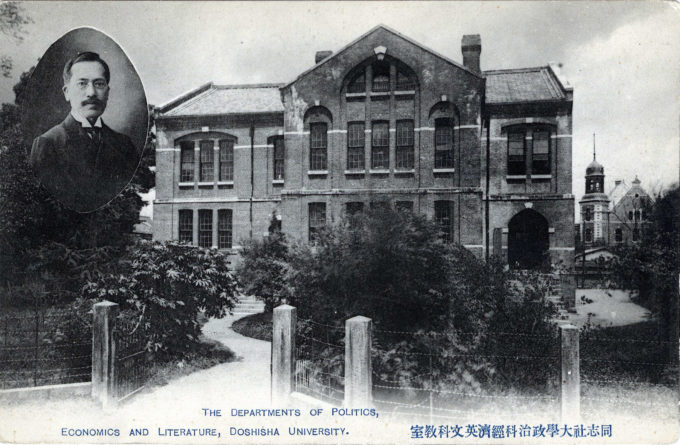
“The Departments of Politics, Economics and Literature”, Doshisha University, c. 1920. The inset photo is of the university’s founder, Joseph Neesima (born Niijima Shimeta), who secretly left Japan in 1864 for the United States in violation of the Tokugawa sakoku edict that had effectively isolated Japan from the rest of world for 214 years. After the Restoration, when the Iwakura Mission visited the United States in 1871 on its around-the-world expedition, Neesima assisted as an interpreter, traveling with the Mission for more than a year, in Europe and the United States, befriended by two important bureaucrats who would prove vital to the establishment of his Doshisha English School in 1875 which, by 1920, had been granted university status by the government. Niijima’s wife, Yamamoto Yaeko, would later found Doshisha Girls’ School (now Doshisha Women’s College of Liberal Arts) in 1876. In 2013, Doshisha University was ranked fourth among Japanese private universities for “schools to which parents wish to send their child.”
See also:
Akamon (Red Gate), Tokyo Imperial University, c. 1905.
Kyushu Imperial University, c. 1930.
Sophia University, Yotsuya, Tokyo, c. 1930.
Rikkyo (St. Paul’s) University
“According to a correspondent of the East and West News Bureau, the emperor of Japan recently granted a sum of money, out of his civil list, to the Doshisha University in Kioto. The emperor rewarded the Doshisha for its educational services on the twenty-fifth anniversary of the death of its founder, Joseph Niishima.
“… Because he had assisted Japanese dignitaries in their missions to the Occident, when there were few Japanese who spoke English, they assisted him in their turn to organize the first Japanese Christian school forty years ago. Upon the death of its founder Doshisha school won the moral backing and financial support of the Congregational missions of the United States, which enabled the school to develop into the first private private university in Japan. The Doshisha University now has colleges for divinity, politics and economics, and English literature, with more than 1,000 scholars in these colleges and preparatory schools.
“The Imperial recognition of the Doshisha University synchronizes the passage in the Education Investigation Council of the amendment that colleges giving four or more years of education to secondary school graduates shall be called universities … This education reform, which has been discussed for the last twenty years, will at last place the private colleges and special schools on the footing of equality with government institutions, whose graduates of hitherto almost monopolized privileges of perferment.”
– School and Society, edited by J. McKeen Cattell, July-December 1915
“Doshisha University was founded in 1875 by Protestant educator Niijima Jō (also known as Joseph Hardy Niishima) as ‘Doshisha English School’, a school to advance Christian education in Japan. In 1920 it was granted university status. The university now encompasses 14 faculties and 16 graduate schools with numerous affiliated institutions including Doshisha Women’s College of Liberal Arts.
“As a young man, despite the ban enacted by the Tokugawa bafuku on overseas travel then imposed on Japanese nationals, Niijima took flight Japan for the United States in 1864 aboard the American brig Berlin. Sponsored by an American couple from Andover, Massachusetts, he attended Phillips Academy and graduated from Amherst College with a bachelor degree before going on to study at Andover Theological Seminary where he was ordained as the first Japanese Congregational minister.
“Niijima returned to Japan in 1874. The next year, he established the Doshisha English School. Niijima served as president of the university from 1875 to 1890. Other early university presidents included educator and author Yamamoto Kakuma (1890–1892), Seito Saibara (1899–1902) who was the first Christian member of the Japanese Diet, and prominent chemical engineer Kotaro Shimomura (1904-1907).
“The university is considered one of the most selective private universities in Japan. The acceptance rate for the 40,924 applicants for the 2014 academic year was 35.6%, with acceptance rate in some departments under 15%. In 2013, the university was ranked fourth among Japanese private universities for ‘schools to which parents wish to send their child,’ following Waseda University, Keio University, and Meiji University – all in Tokyo.”
![“Bird’s-eye view from [the] east, Doshisha University”, Kyoto, c. 1910.](https://www.oldtokyo.com/wp-content/uploads/2023/04/scan0005-680x446.jpg)
“Bird’s-eye view from [the] east, Doshisha University”, Kyoto, c. 1910, looking toward Recitation Hall.
- “Yushikwan, Kofukwan, Chienkwan”, Doshisha University, c. 1920.
- Doshisha Library, Doshisha University, c. 1920.


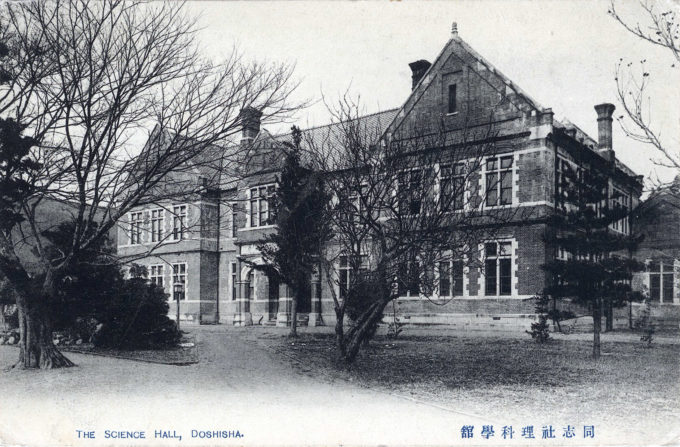
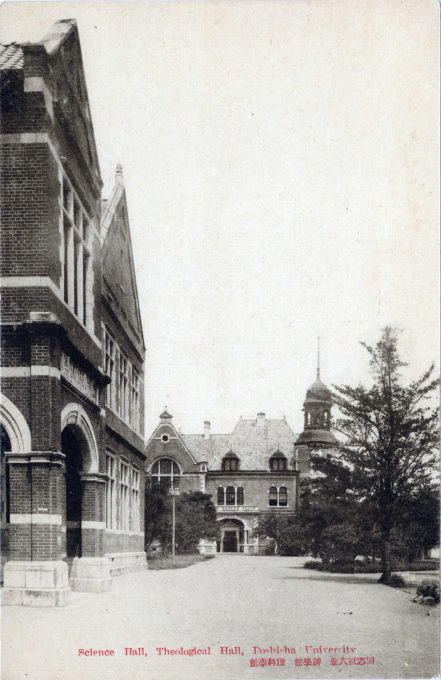
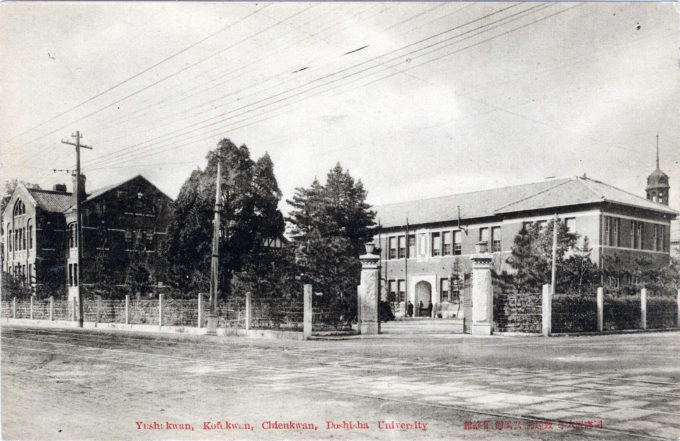
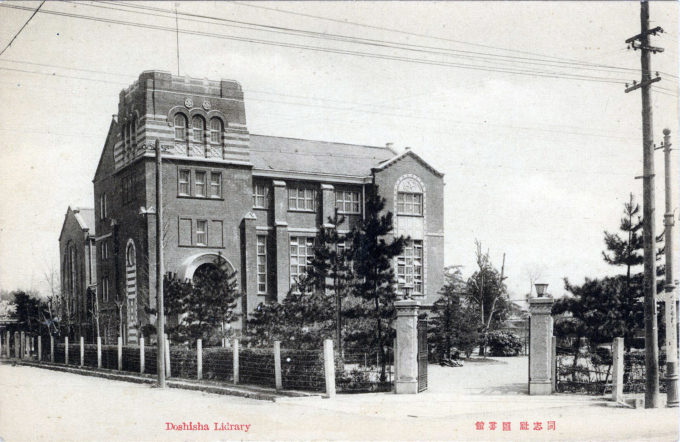
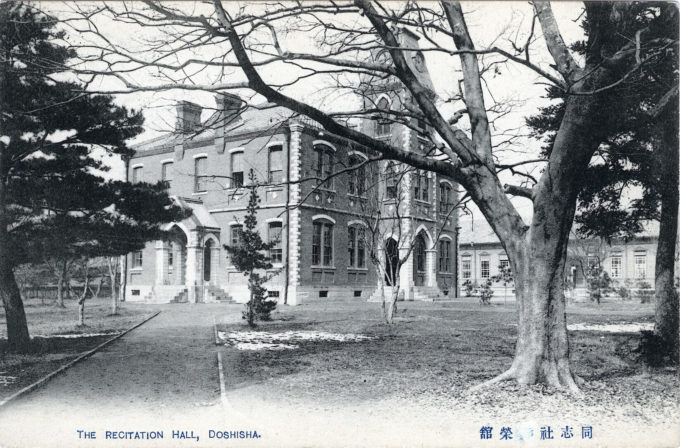
Pingback: 30th Anniversary of the Naniwa (Osaka) Christ Church, 1907. | Old Tokyo